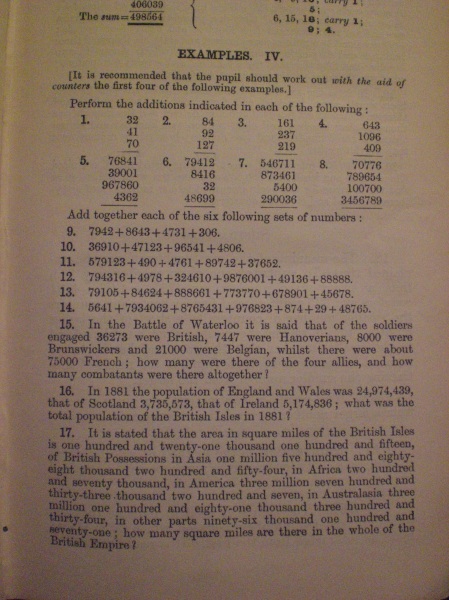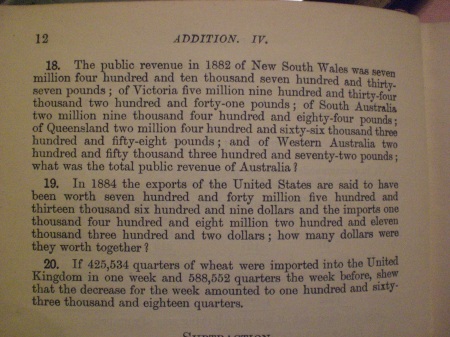To those who are concerned with current math education, I am eager to share my first in a regular series of posts showing some pages from an excellent English arithmetic book written in the 1880’s. I think my readers will be very interested to compare these with current text books and methods.
How do these problems compare with those which might be taught today in India, China, Japan, Korea, Singapore, Hong Kong, Russia, Australia, European countries, or South America?

John Bascombe Lock's books are still in print after 120 years. "Trigonometry for Beginners" (for sale at Barnes and Noble online) is just one of his numerous volumes.
John Bascombe Lock (1849-1921) first published his Arithmetic for Schools in Britain, in 1886. I have an 1897 edition, which boasts of containing a full 8000 problems in its 448 pages (but which in a hardback volume is the typical size and weight of a current paperback book). I got my copy in about 1978, long before I became a teacher, in an antique store located in America.
In case any readers are interested, an American edition of Arithmetic for Schools can be downloaded for free from Barnes and Noble HERE.
Now with two decades of teaching under my belt, I find this book still helpful to me and fascinating to peruse regularly. While I’ve never been able to precisely determine for which level this book is written, my best guess is that it corresponds with what would today be middle school, or Grades 7-8 (ages 12-14). It contains no algebra, only basic arithmetic.
Lock served as a master at Eton, then fellow (senior academic lecturer or professor involved in full-time teaching and research) and bursar (official in charge of funds) of Gonville and Caius College, Cambridge.
Finally, here are a few examples of the additon exercises in the book:
Reactions?
–Lynne Diligent
Other Math Education Articles by Lynne Diligent:
Why So Many Elementary Students Aren’t Mastering Basic Math Facts (Part 1)
Why So Many Elementary Students Aren’t Mastering Basic Math Facts (Part 2)
Tags: Arithmetic for Schools by Rev. J.B. Lock M.A., British arithmetic, Eton College, falling standards in math education, going back to the basics in arithmetic and math education, John Bascombe Lock master at Eton and math fellow at Gonville and Caius College in Cambridge, middle school addition arithmetic and story word problems, Rev. J.B. Lock, traditional middle school math education in arithmetic example problems




August 4, 2011 at 2:45 pm |
Stanley Hartzler earned his Ph.D. in mathematics education from the University of Texas with a dissertation on the quality/content of algebra textbooks from 1806-1982. It was (and is) the most definitive study of algebra homework problems available through 1982. His conclusion? The older textbooks at the turn of the century were superior to those of more recent date in terms of “clarity, singularity of purpose and appropriate level of difficulty.” He added that “superior mathematics students at the University of Texas-Austin still use Chrystal’s Algebra from that same era to prepare for the Putnam Examination, the cornerstone of intercollegiate mathematics competition.
Further, Dr. Hartzler maintained that John Saxon’s Algebra 1 textbook (published in 1981) was superior to any other contemporary math book. He slammed all other modern algebra books as being the “worst ever published with regards to learning design and weaknesses in and fragmentation of content.”
He is quoted in a biography titled John Saxon’s Story, a genius of common sense in math education, by Nakonia (Niki) Hayes.